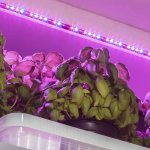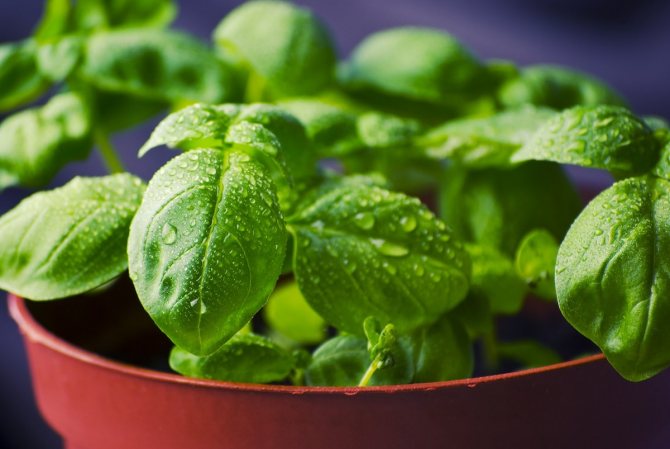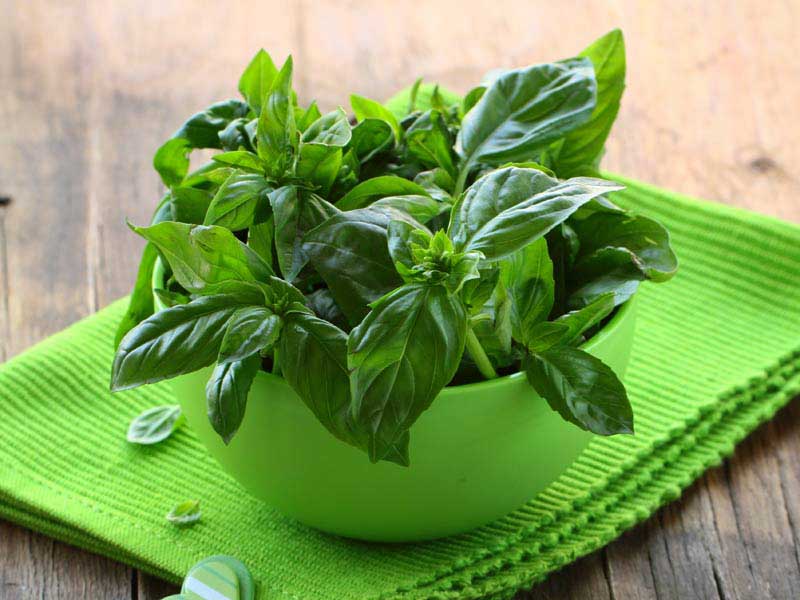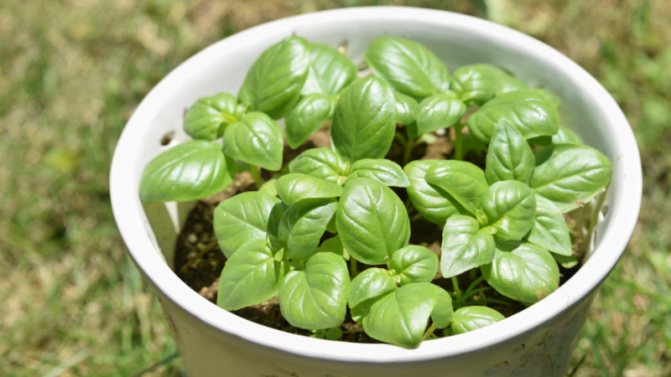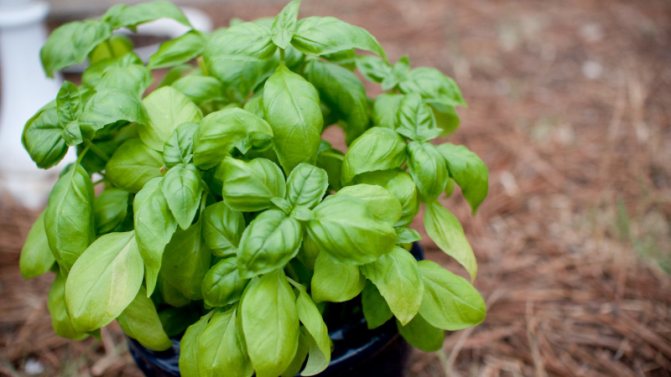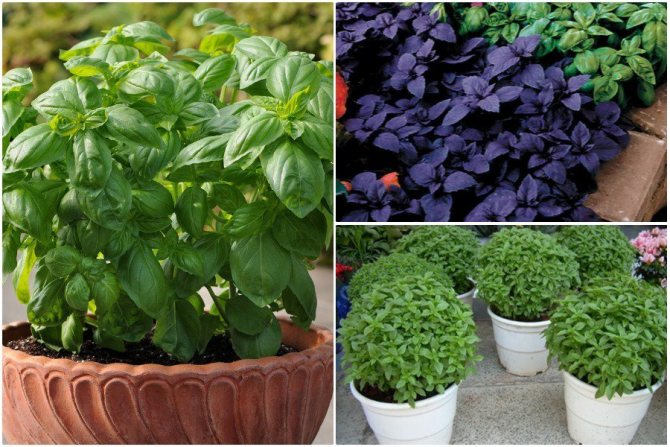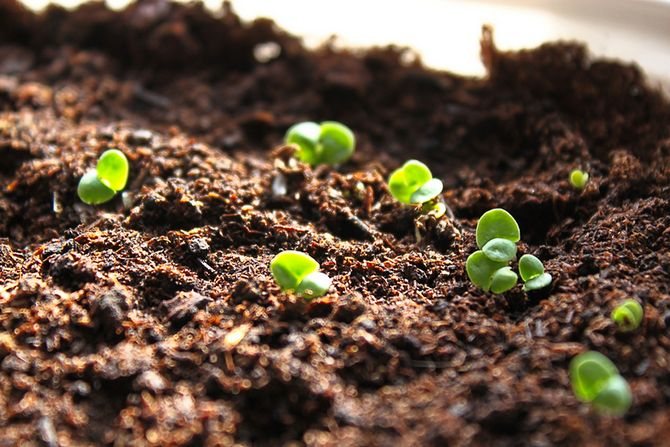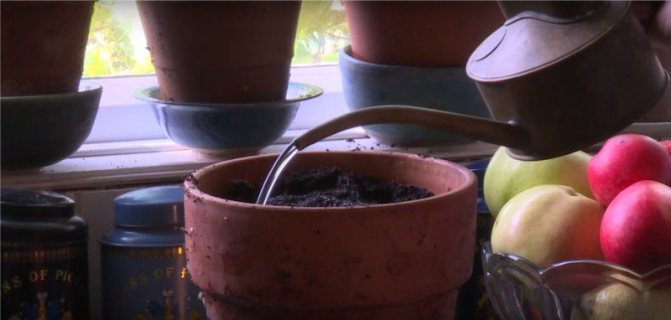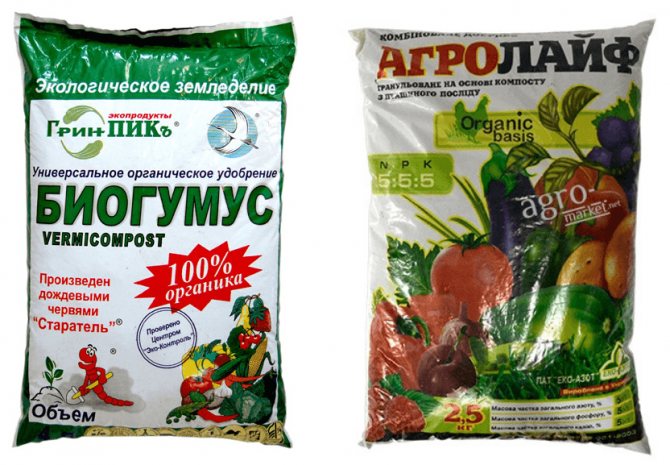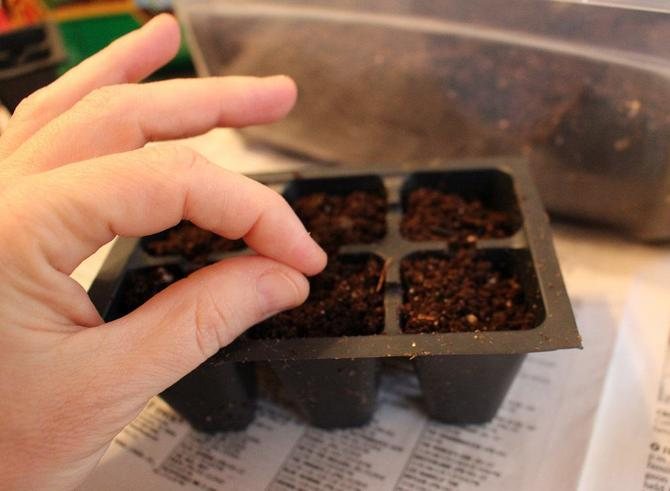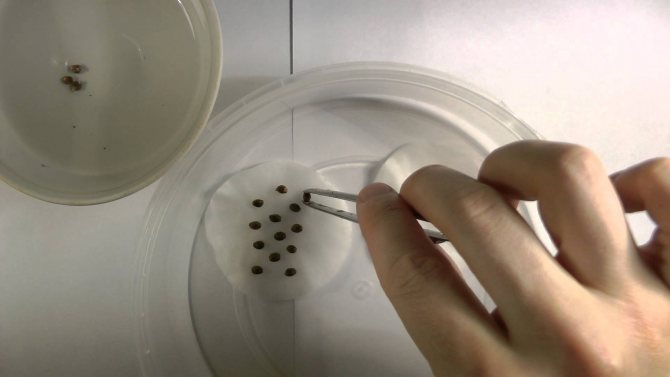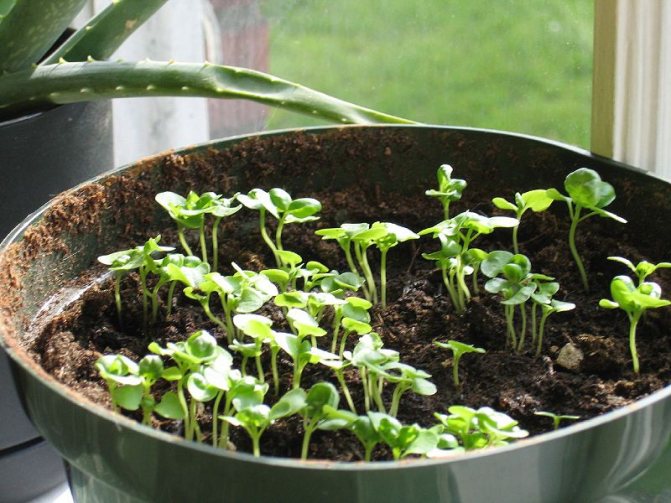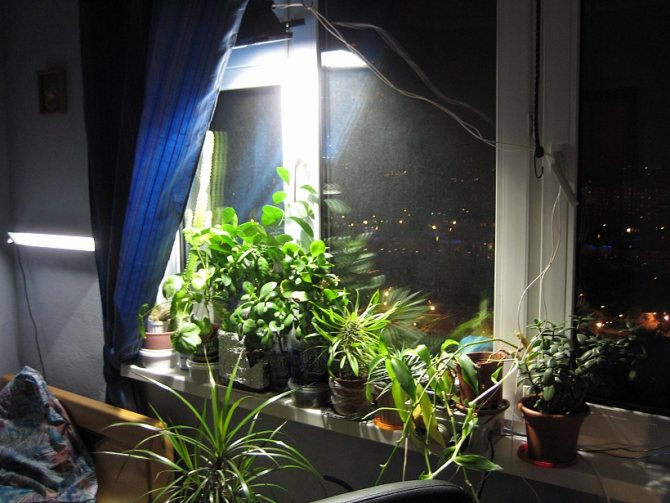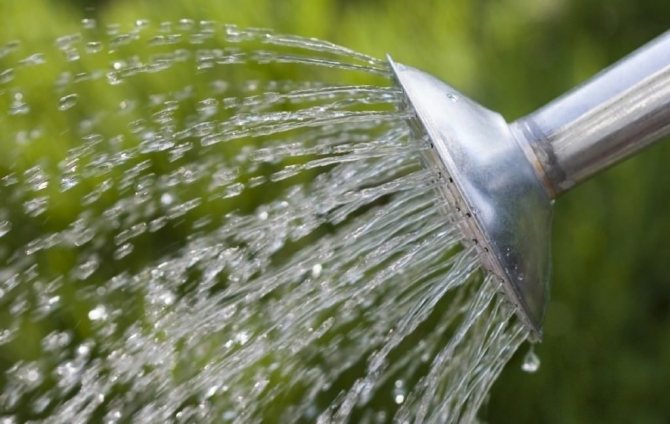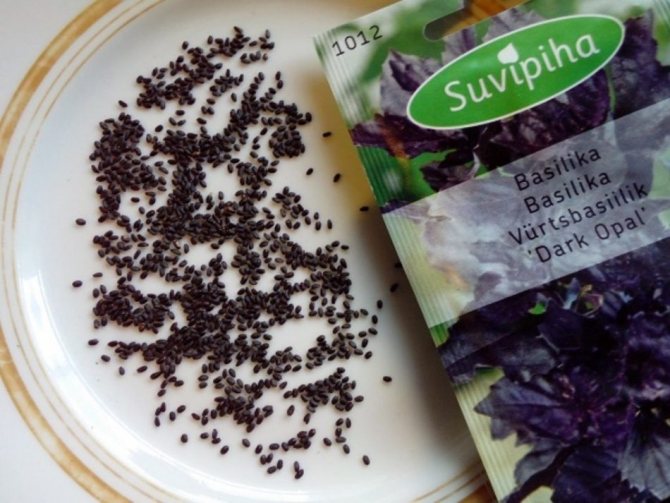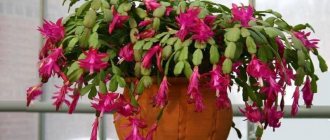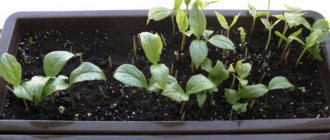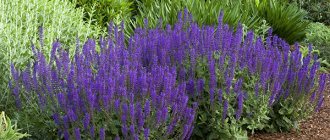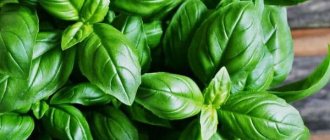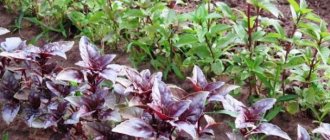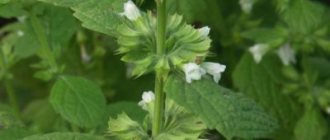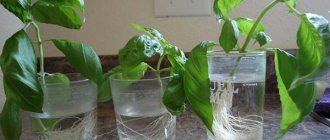Basil is a herb that contains a lot of essential oils that give it a pleasant scent. There are many varieties of annuals and perennials. Branches, leaves and flowers serve as a versatile seasoning that is added to various dishes, marinades, salads and pastries. Growing basil on the windowsill, you can enjoy fresh fragrant greens at any time. In order for the plant to grow well, to give a rich harvest, experienced gardeners are advised to plant, starting from the lunar calendar. The best time for landing is the arriving moon.
Features of growing basil on a windowsill
Basil is an indispensable ingredient for people who care about their health and maintain their figure. At the same time, it is enough to eat only a few branches of greens a day in order to provide the body with useful vitamins and microelements.
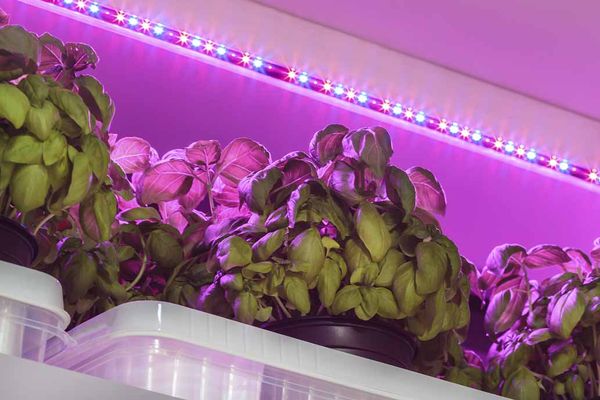
To grow basil on a windowsill, you need to carefully prepare, as this will require:
- decide on a variety and purchase seeds or cut fresh cuttings from an adult plant;
- choose a suitable place (window sill) in the apartment;
- prepare planting containers and nutrient substrate;
- to carry out pre-sowing preparation and seed treatment;
- to study the features of watering and feeding;
- get acquainted with possible diseases and measures to combat them.
Important! Basil on the windowsill is very responsive to care and therefore requires increased attention, since it cannot stand ignoring the rules of its maintenance.
Without a doubt, basil can be successfully grown on a windowsill and enjoy its taste for a long time only if its planting and further care are carried out according to the rules.
Video: how to grow basil at home
Planting capacity and soil for basil
For growing a basil bush at home, long wooden containers or elongated clay flower pots are ideal, the main thing is that they are sufficiently voluminous, since the root system grows abundantly.
It is best to warm up the soil before planting and fertilize with mineral fertilizing or humic concentrate.
The container chosen should be well drained to prevent fluid stagnation. For planting this plant, black soil and sandy loam are suitable.
Choosing the Right Basil Varieties for Home Growing
To successfully grow basil in an apartment, you need to choose the right plant variety, since not all varieties can adapt and grow on the windowsill. Optimally select small-leaved and compact species.
In addition to its excellent taste and aroma, basil attracts home gardeners with its decorative properties, therefore, by planting greens with different shades of foliage, you can create a special comfort in the house.


Thus, for growing basil on the windowsill, varieties such as Basilisk, Delight, Clove, Marquis, Dwarf, Yerevan, Orion, Lemon, Purple glitter, Thai Queen, Philosopher, Green scent, Tabletop, Red Ruby and others are suitable.


The variety of plant varieties allows you to choose a variety based on your individual preferences, and the best option may be to grow several varieties of basil on the windowsill at once.


Optimal sowing time
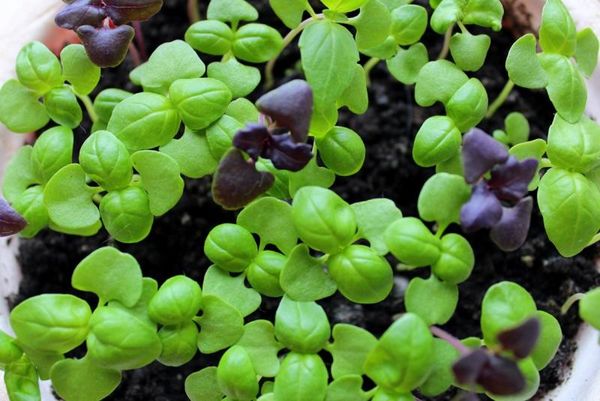

Basil seedlings are usually sown in March or April. The timing is shifted depending on the climate and the method of growing greenery - in open beds or in a greenhouse. In regions with a temperate climate, the grown seedlings are transplanted to a permanent place in the first decade of June. In the southern part of the country, this opportunity comes in the second half of May. In order for basil to develop well in open beds, you need stable warm weather with an air temperature above + 10 ° C, a well-heated soil, and no threat of recurrent frosts. To accurately determine the timing of sowing, use the following scheme:
- The starting point is the estimated date of planting grown seedlings in open ground.
- 60 days are counted back from it. This time is necessary for the development of seedlings.
- For seed germination and emergence of seedlings, another 14 days are given.
- If the seedlings are grown with a pick, they take another 5 days to adapt the bushes in a new place. As a result, the optimal sowing date is obtained.
For a more accurate determination of planting dates, the characteristics of the variety are taken into account. Medium and late varieties of spice develop more slowly. Such seeds are sown several days earlier. The planting date of the early and mid-early basilicas is shifted to the other side. Due to the rapid development with premature sowing, the seedlings of such varieties outgrow and then hardly take root in a permanent place.
Important!
With the further cultivation of basil in the greenhouse, the seedlings are planted 2 weeks earlier.
Growing basil from seeds on a windowsill: step by step instructions
Before sowing seeds, you should choose a suitable container, soil, and only if you wish, you can prepare - soak and germinate the planting material itself.
In what container to grow
For the initial sowing of basil seeds on seedlings, it is recommended to use any flat containers or bowls.
It is very convenient to grow basil seedlings in individual cassettes.
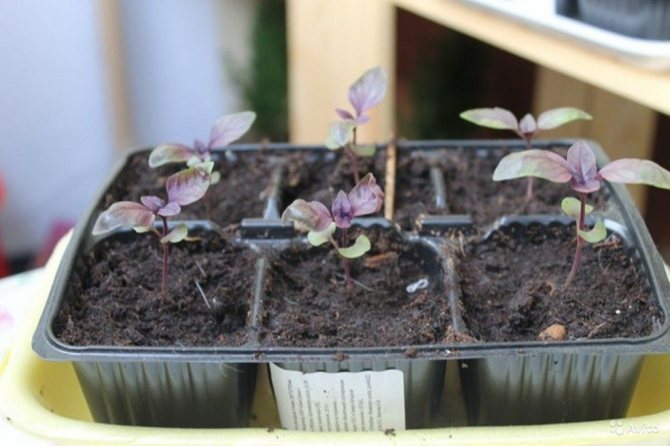

In the future, for planting seedlings, it is necessary to find already more spacious pots, at least 15 cm deep.
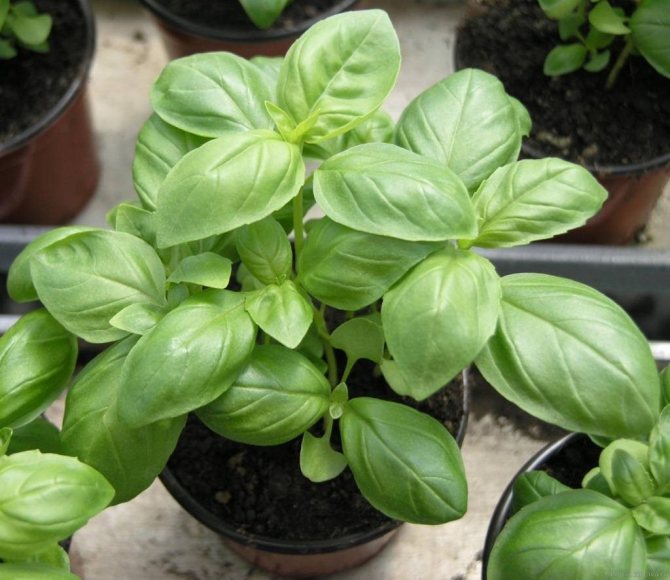

Do not forget about drainage: at the bottom of the planting containers there should be at least holes so that excess water is drained into the pan, and a 3 cm layer of expanded clay is poured in permanent pots.
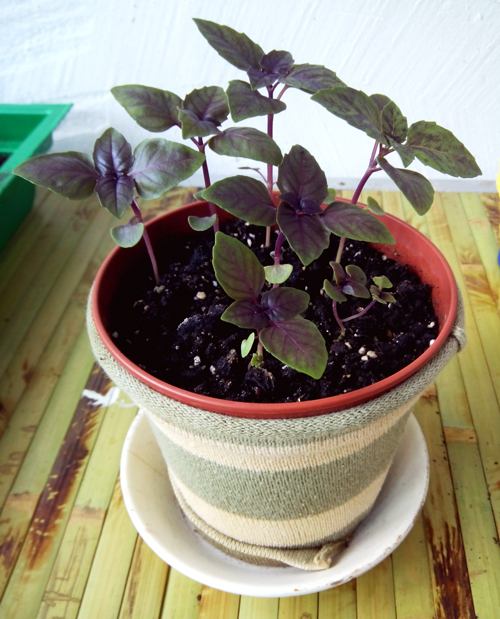

Required potting mix
A substrate for sowing basil seeds or rooting cuttings at home is suitable for the most ordinary - universal for growing seedlings, which you can buy at any gardening store. The main thing is that it must meet the basic requirement - to be light and loose, which means that it allows air to pass to the root system and does not retain moisture.
Prepare soil for growing basil in the following ways from the following components:
- humus, garden soil and peat (1: 1: 1);
- humus and coconut fibers (2: 1).
Important! Before sowing seeds or rooting cuttings, the soil should be disinfected, and any, even purchased. This can be done by steaming it in a double boiler or roasting it in the oven. In addition, it is additionally recommended to shed the soil with a pink solution of potassium permanganate or Fitosporin.
Seed preparation
Before sowing, it is required to prepare the planting material, which will improve germination and promote uniform seed germination.


But! It is believed that basil grows well on moist soil even without any pre-sowing preparation (soaking).
For example, you can first soak basil seeds in hot water (about 70 degrees) for 15 minutes, and then put them on a damp cloth (or cotton pads). As a rule, seeds hatch within 1-2 days.
After that, you can additionally process (disinfect) the seeds in a pink solution of potassium permanganate for 10-20 minutes.
Advice! The hatched seeds can be planted at some distance from each other, so that later they do not dive or thin out.
Direct sowing of seeds
The successful cultivation of basil at home largely depends on the correct sowing.
Step-by-step instructions for sowing basil seeds for further cultivation on a windowsill:
- Pour the substrate into the prepared pots (at the same time, you should not fill it completely, somewhere 2/3 will be quite enough).
- Level the ground surface and compact.
- Moisten the soil with a spray bottle.
- Spread the prepared seeds evenly, slightly pressing them into the soil (no more than 0.5-1 cm).
Dry seeds are sown superficially, and already sprouted seeds can be lightly sprinkled with earth (1-1.5 cm).
- Moisten crops by spraying from a sprayer.
- Cover the container with a transparent lid or plastic wrap to create a greenhouse effect.
- Place the container in a dark and warm place (optimum temperature +25 degrees) until shoots appear.
Basil cuttings
Basil can be grown at home two ways:
- from seeds;
- from cuttings.


If you already have a growing basil in your house or friends, you can cut cuttings from it using the upper and middle parts of the stem. You can also purchase a small container of growing basil in the store, if it is fresh, it may well serve source of cuttings.
The cuttings are placed in water, the roots usually appear within a week, after two weeks they can be planted in the ground. Possibly also rooting cuttings immediately in the ground, from above they need to be covered with cans or cut PET bottles, to increase the likelihood of successful rooting, add a root formation stimulator when watering.
Basil takes root quite well during vegetative propagation, and when planting cuttings or seedlings, they quickly reach a size that allows harvest.
But barely rooted cuttings are quite fragile, but sprouts that have grown from seeds are not so delicate, therefore sowing basil is considered more practical option, although it takes more time to wait for the harvest.
Transplanting basil from open ground to a pot
Advice! It is optimal to transplant at the end of the summer season (in September), so to speak, taking the plant home for the winter.
In general, the easiest way is to dig up and transplant a young basil bush from open ground into a pot. It is more than easy to do this: they dug it out with a lump of earth, put the plant in a pot, at the bottom of which there is already drainage (holes and a layer of expanded clay), poured earth on the sides, watered it and put it on a light windowsill.
By the way! In order for the bush to renew itself, after transplanting, trim its top, which you can use as a cutting.
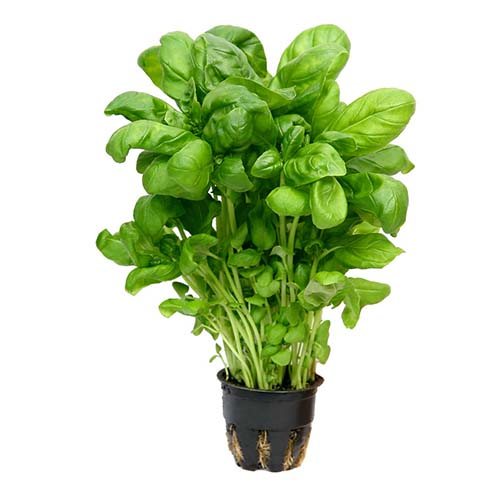

Interesting! You can also grow basil on the windowsill (or any other greens) by simply buying greens in a pot in a supermarket, and then planting its rhizomes in the ground, first treating (sprinkling) them with one of the growth and root formation stimulants (Zircon, Epin or Kornevin).
Pests and diseases
Potted basil can be attacked by insects that harm the plant. Most often, spicy grass suffers from aphids, which suck juices from its branches and leaves. The leaf plates curl up, the shoots stop developing, the bush dries up. With the basil brought from the street, the larvae of the sap-eating field bug can be brought in. The leaves are also deformed, whitish spots appear on them, gradually becoming brown, later they fly around. It is imperative to take appropriate measures.
Basil, although it is resistant to diseases, but nevertheless they can infect it, fusarium is considered one of the serious fungal infections. The disease leads to yellowing and thinning of the foliage. The root is affected, as a result, the bush begins to fade.It is often possible to see that the branches of the plant have become black, which means that they have become ill with a black leg. The shoots will begin to fall, turn yellow, and as a result, the basil will die. The causes of infection are poor air exchange, sour soil and abundant watering. Another disease found in basil is gray rot. The fungus infects the foliage, it becomes covered with light brown spots. With the development of the disease, the number of sore spots increases, you can observe the appearance of a grayish cannon. If you do not start to heal on time, the bush can be lost.
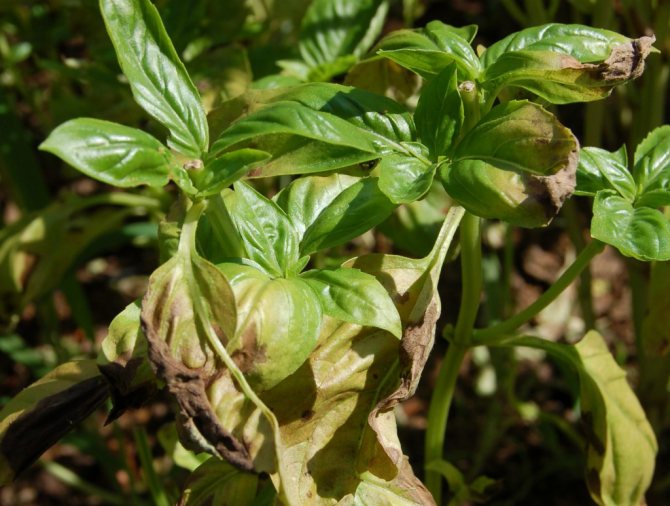

Shoots are treated with drugs:
- "Hom";
- "Copper sulfate";
- Oxyhom;
- bordeaux liquid.
It is not possible to save the neglected plants, however, if there are still healthy shoots on it, it is necessary to cut them off, examine the cut off place. If the cut tissue is clean, soak it in a solution of a fungicidal agent and root it in pre-calcined sand. It is imperative to use growth biostimulants such as Zircon or Kornevin.
There are preventive measures for all fungal diseases. It is necessary to disinfect seeds, cuttings, soil and pots, and form a drainage layer. With the help of ash, it is necessary to restore the acid balance of the soil, thin out the seedlings, water it moderately, and loosen the soil. Fertilizers should be applied in strict proportions. The apartment must be ventilated.
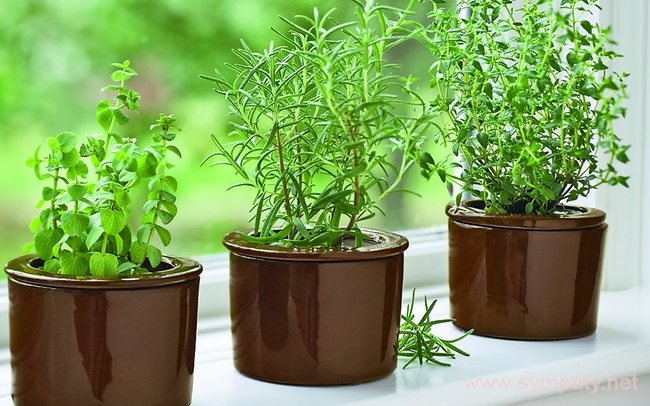

Growing basil from cuttings on a windowsill
Cutting is perhaps the fastest way to get basil greens in just a few weeks.
Where to get cuttings? They can be cut directly from the basil bush, if you have one on the site. Or just buy packaging at the supermarket. The main thing is that the greens are not sluggish.
The stalk should be 5 centimeters long. All the extra lower leaves should be cut off from him, and you can additionally cut off the upper leaves by half.
The very rooting of basil cuttings is carried out in the standard way: put the cuttings in water, and the container itself in a bright place, for example, on the same windowsill.


Advice! The water in the container should be changed as often as possible, optimally every day.
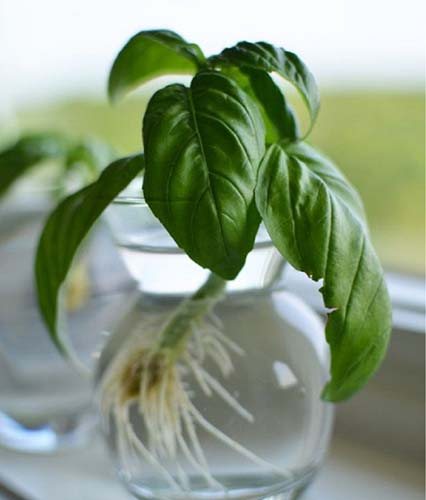

After 7-10 days, you will already notice small roots on the cuttings, and as soon as they reach a length of 3-4 cm, the sprouted basil cuttings can be transplanted into a pot with soil.


Further cultivation of basil is carried out in the same way as planted with seeds.
Or you can do it differently: first, as usual, cut the cuttings, cut off the excess leaves. Then immediately plant them in containers with earth (humus) and cover them with something on top, for example, a plastic bag or a plastic lid to create a greenhouse effect.
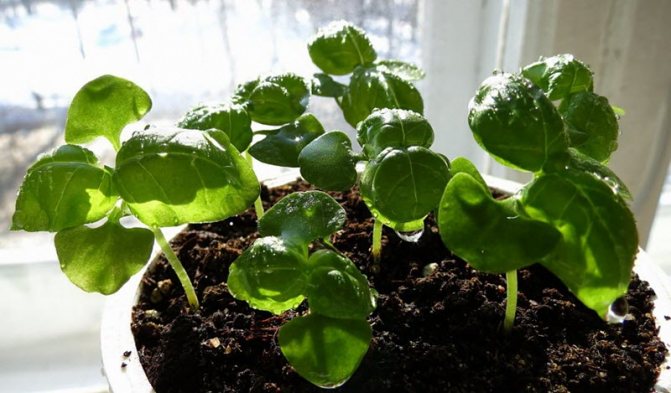

Video: how to grow basil at home by planting cuttings directly into the ground
Preparing a site for planting a basil
Seat selection
A thermophilic plant requires appropriate conditions. Find an open, sunny area on the south or southeast side. Drafts and cold gusts of wind can damage the plant. Plant basil in a secluded place: along fences, buildings, between bushes.
The soil needs light, loose, fertile, permeable to water and air.
Predecessors
Desirable precursors: cucumbers, tomatoes, peas, beans, beans, lentils, lupins. Basil should not be cultivated in the same place for several years in a row, as this provokes fusarium disease (brown spots on the leaves). You can return the basil to its original place after 5 years.
Taking care of basil on the windowsill
When friendly shoots appear (with the method of growing from seeds) the container should be placed in a bright place (window) and the temperature should be lowered to +20 degrees, which will prevent stretching of the plants.
Also, if you wish, you can begin to adapt the seedlings to environmental conditions.To do this, you need to start gradually removing the shelter from the container (first for 30 minutes a day, then for an hour), which will allow the seedlings to gradually get used to the new conditions. After 7-10 days, the shelter must be completely removed.
By the way! Many do not carry out any adaptation, and the shelter is removed immediately after germination.
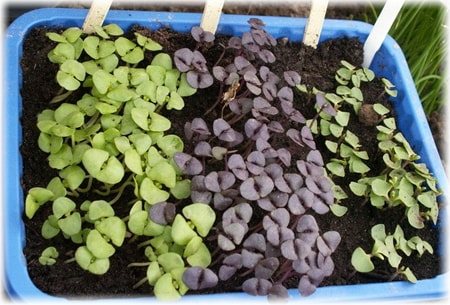

By the way! When the basil grows a little (up to 5-7 in height), pour 2-3 cm of earth under the elongated sprouts.
Pick or thinning
As soon as the seedlings get stronger, they will significantly increase in growth, and they will have 1-2 real leaves, you can spend pick plants in separate, more spacious containers, if initially you planted in a common and shallow one.
Video: sowing basil and picking seedlings
By the way! Otherwise, if you sowed immediately into a permanent container of the optimal size, you can simply thin out the seedlings, leaving the strongest ones so that there is a sufficient distance between them (5-10 cm).
Choosing a suitable place and conditions of detention: lighting, temperature
Basil prefers to grow in nature in open areas and at elevated temperatures, in other words, the place should be warm and sunny. Therefore, in order to grow basil at home, on the windowsill, it is imperative to take these preferences into account and choose a place that is as close as possible to the natural conditions for the growth of aromatic greens.


Best for growing basil at home south sill, but, in principle, you can place greenery on the east or west window. In a sense, this is an even more profitable place, because during the period of excessively active sun in the spring and on hot summer days, if the plant is located on the south window, you will absolutely need to shade the basil to avoid burning the foliage.
Important! This tropical greenery does not tolerate drafts very well. Therefore, be sure to seal the cracks in the window frames for the winter.
Since the plant loves warmth, the air temperature should not fall below + 18-20 degrees, otherwise it will slow down its growth and stop developing. It is optimal for the temperature to be kept within + 22-25 degrees.
By the way! When it becomes warm enough outside, the basil pots can be taken out to the balcony or loggia.
For the full growth of the basil at home on the windowsill you need at least 12 hours of daylight hours, and preferably 14-16 hours, therefore, during the period of short days (especially in late autumn, winter and early spring), it is recommended to provide the plant with additional lighting, illuminating it with the help of special phytolamps or full-spectrum LED lamps.
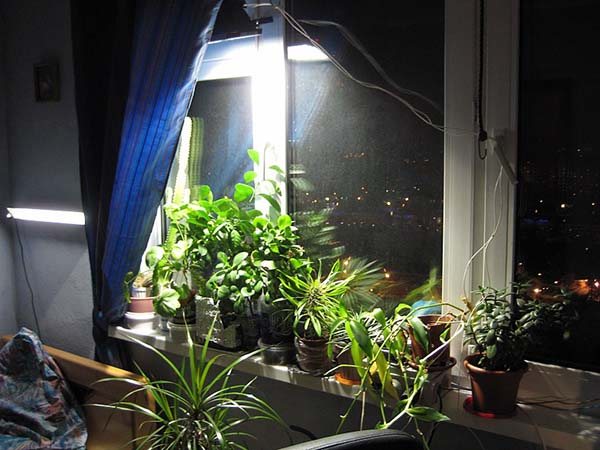

Important! In winter, in the morning and evening hours, as well as when it is cloudy, it is worth turning on the phytolamps so that the daylight hours are at least 12 hours.
Watering
Watering is carried out as needed, avoiding drying out and excessive moisture of the earthen coma.
Watering itself should be carried out with settled water at room temperature.
The regularity of moistening the soil in a pot directly depends on the temperature regime: the higher the temperature, the more often you water.
In winter, if you have a special cool place for greenery, watering should be significantly reduced.
Also, basil grown at home needs high air humidity, therefore, if the room is dry, then the foliage of the plant must be sprayed additionally. This is especially true in the cold period of time, when central heating batteries are "fried".
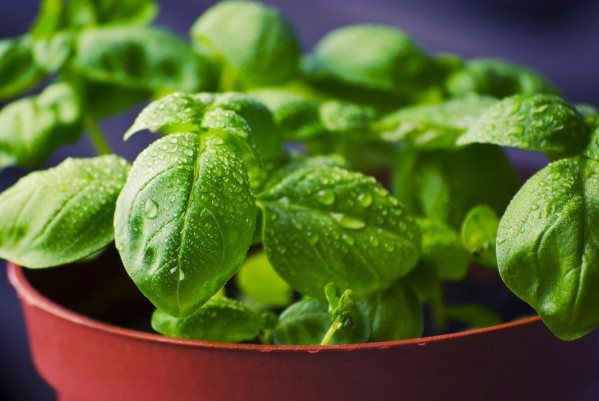

On especially hot days, a pot of basil can be placed in a container filled with expanded clay filled with water. This will increase the evaporation of moisture and thus increase the humidity in the air.
By the way! If you notice that after watering, due to excessively dry air, a crust forms on the surface of the soil, then you should carry out loosening.
Top dressing
After transplanting the basil seedlings into a permanent pot, it is worth starting to carry out regular feeding, using any universal fertilizer for this.Will do: "Barrel", "Agricola", "Energen".
Pinching
In order for the plant to bush better when the basil is still small (1-1.5 months after sowing, when it has 4-6 true leaves), its top should be pinched so that the plant grows not only upward, but also gives side shoots.
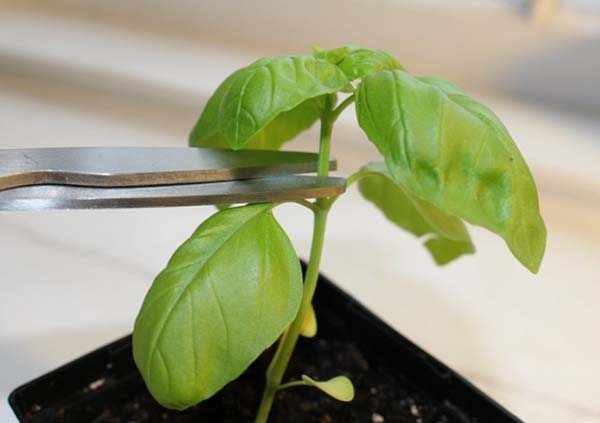

Important! When flower stalks appear on the plant, they must be promptly cut off with scissors, since after flowering, the basil greens become tough and lose their aroma.
How to properly care for and water
- Choose the sunniest window in the room. You can also use a balcony, but during cold snaps, the pot will need to be brought into the room, or covered.
- The best time to plant basil is March-April. At this time, warmth and daylight hours increase. These conditions help the plant during the active growth period.
- It is best to water basil in the first half of the day, because during the night the air in the room becomes noticeably cooler, and accordingly less liquid will evaporate. If the batteries in the room are heated very strongly, then the mini-gardens will have to be irrigated more often: once in the morning, once in the afternoon.
- Basil loves spraying from a spray bottle, however, this should be done gently and in moderation, and only in the morning.
- Loosen the soil 2 times a week before each top dressing. This will enrich the earth with oxygen and allow water to get to the roots without any problems.
- Basil is a disease-resistant plant. However, if you constantly fill it with water and keep it on a cold window, fungal diseases cannot be avoided. More often it is susceptible to gray, black rot, fusarium. As a preventive measure, brew the onion peel with boiling water, in a ratio of 1 to 4. The solution is insisted for 24 hours in a dark place, filtered and periodically sprinkled with soil at the roots. If signs of the disease appear on the leaves, they need to be cut off, and the basil should be treated with fungicides (Fundazol, Topaz, Fitosporin). But if the spots have gone along the stem, the plant, alas, will not help. It should be removed, the pot is processed with potassium permanganate.
- Use small pebbles or expanded clay for drainage. They can be picked from nature or purchased from a gardening store. But before using it, be sure to rinse it under the tap, dry it, and then bake it in the oven.


When to Harvest Homemade Basil
Basil leaves can be used for food when the plant reaches 15 cm in height. At this stage, as a rule, the formation of the main stem of the plant is completed, so the loss of leaves will not affect the development of the basil.
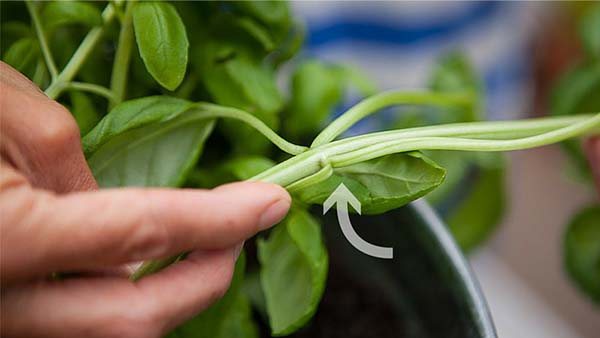

Note! However, you cannot break off the stems, otherwise the plant will dry out. You can only collect the leaves (lateral), and it is the top ones. It is better to cut them off with scissors, and not open them, because this can damage the stem.
Naturally, when growing basil from seeds, ripening and harvesting will occur much later than when planting by cuttings:
- when grown from cuttings - 3-4 weeks after rooting;
- from seeds - after 3-4 months.
By the way! You can also grow on the windowsill other types of herbs and herbs (dill, parsley, green onions, spinach, rosemary, mint), as well as vegetables (cucumbers, tomato, hot peppers, radish) and even berry bushes (strawberries).
Having mastered the technique of growing basil on the windowsill, you can provide yourself and your family with fresh greens all year round, including in winter. And then the cooked dishes will have a special taste and aroma no matter what time of year it is outside the window.
Video: growing basil on a windowsill
Harvesting and storage
The first time the green leaves are cut when the basil grows up to 15 cm. At this time, the main stem is no longer forming, and cutting the greens will not affect the overall development of the plant. It is recommended to collect the top greens growing on the sides.It is best to use scissors.
Attention!
Experts do not advise breaking off the leaves, the bush may die.
Fresh young foliage, often used in the preparation of salads, various dishes of their meat and fish, canning. Basil can be paired with other fragrant herbs like parsley, dill, and rosemary. The fragrant leaves can be stored in a sufficient amount of water and a place where the sun's rays do not fall. To keep them fresh longer, you need to put them in the form of a bouquet in a glass, pour water over them, cover them with a plastic bag on top and secure with an elastic band. With this storage, the greens will be fresh for about 2 weeks. There is another method in which the cut leaves are poured into a glass jar, a little salt is poured on top, olive oil is poured and covered. Placed in the refrigerator for storage. The spicy herb can be used for 2-3 months.
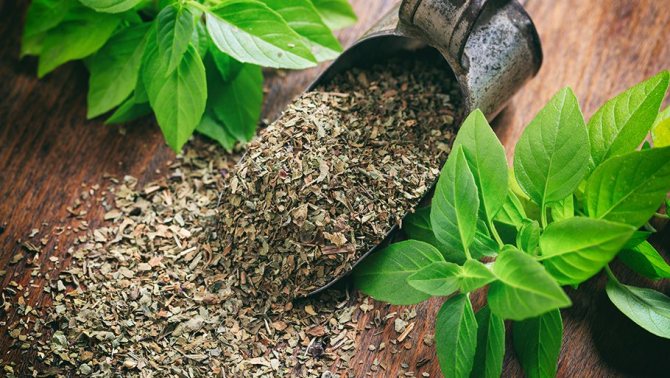

Lighting and temperature control
In order for your green pet to grow well even in winter, he will definitely need:
- a lot of light, since it is a photophilous plant;
- moderate regular watering;
- warm air (+25 degrees);
- breathable soil, light, in which there will be no stagnation of excess water;
- deep container, providing room for its sufficiently voluminous roots.
But what basil does not like at all:
- stagnant moisture;
- cold through air;
- temperature changes;
- lack of light.
Diseases to which the plant is susceptible
Basil, like many other crops, is susceptible to various diseases. Of course, indoor plants are less sick than outdoor plants, but still it is worth protecting yourself. The most common diseases that affect basil are fusarium and gray mold. To prevent your bushes from being struck by such ailments, you need to avoid overflow, since excessive moisture provokes an ailment. If the plant is still unwell, then it is necessary to remove the affected stems in a timely manner so that they do not infect healthy shoots.

